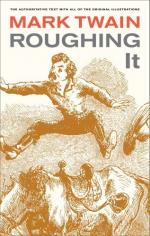The process of amalgamation differed in the various mills, and this included changes in style of pans and other machinery, and a great diversity of opinion existed as to the best in use, but none of the methods employed, involved the principle of milling ore without “screening the tailings.” Of all recreations in the world, screening tailings on a hot day, with a long-handled shovel, is the most undesirable.
At the end of the week the machinery was stopped and we “cleaned up.” That is to say, we got the pulp out of the pans and batteries, and washed the mud patiently away till nothing was left but the long accumulating mass of quicksilver, with its imprisoned treasures. This we made into heavy, compact snow-balls, and piled them up in a bright, luxurious heap for inspection. Making these snow-balls cost me a fine gold ring—that and ignorance together; for the quicksilver invaded the ring with the same facility with which water saturates a sponge—separated its particles and the ring crumbled to pieces.
We put our pile of quicksilver balls into an iron retort that had a pipe leading from it to a pail of water, and then applied a roasting heat. The quicksilver turned to vapor, escaped through the pipe into the pail, and the water turned it into good wholesome quicksilver again. Quicksilver is very costly, and they never waste it. On opening the retort, there was our week’s work—a lump of pure white, frosty looking silver, twice as large as a man’s head. Perhaps a fifth of the mass was gold, but the color of it did not show—would not have shown if two thirds of it had been gold. We melted it up and made a solid brick of it by pouring it into an iron brick-mould.
By such a tedious and laborious process were silver bricks obtained. This mill was but one of many others in operation at the time. The first one in Nevada was built at Egan Canyon and was a small insignificant affair and compared most unfavorably with some of the immense establishments afterwards located at Virginia City and elsewhere.
From our bricks a little corner was chipped off for the “fire-assay”—a method used to determine the proportions of gold, silver and base metals in the mass. This is an interesting process. The chip is hammered out as thin as paper and weighed on scales so fine and sensitive that if you weigh a two-inch scrap of paper on them and then write your name on the paper with a course, soft pencil and weigh it again, the scales will take marked notice of the addition.




